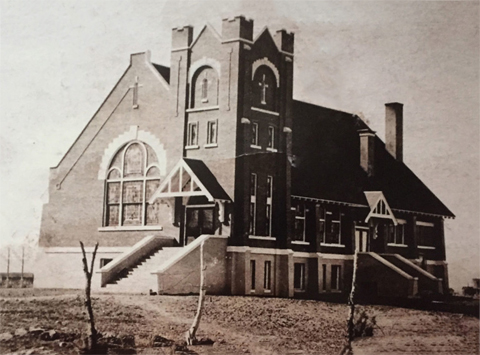Richard Jenkins Davis was the son of William Davis Jenkins and Gwenllian Thomas. He was born at Ystrad Parish, Glamorganshire, South Wales on 3 September 1826. His father died when he was a very young boy and he lived with his grandfather, Richard Thomas, doing farm work. Later he worked in the coal mines. While working in the mines at Llant Parish, he met and married Rebecca Morgan in July 1849.
On 23 January 1851, he was baptized and confirmed a member of the Church of Jesus Christ of Latter-day Saints. He was ordained a Priest on 11 April 1851 by William Jones. He was ordained an Elder on 21 May 1851 and was appointed a counselor to the President of the Llanstwit (Llantwit) Branch of the Myrther (Merthyr) Conference where he labored until 25 January 1853, when he bid goodbye to his friends, relatives and native land, and started for America with his wife and two year old son. They left Liverpool on the ship “Jersey” on 5 February 1853. After six weeks on the ship, they landed at New Orleans and took a steamer up the Mississippi River and landed at Kerkerk (Keokuk), Iowa. They stayed there nine weeks preparing to cross the plains. After a hard trip and much suffering, common to those days, they landed in Salt Lake City on 10 September 1853. They spent the winter with old Father Call at Bountiful and in the spring of 1854 they moved to Willard.
He entered into the activities of this community, building one of the first substantial houses. In connection with Will Walker, they opened the first road in the Willow Creek Canyon.
On 3 February 1859, he was set apart as one of the seven Presidents of Seventy in the 59th Quorum which was organized the same day. On 6 April 1865, he was called to fill a mission to Wales. He left Willard 10 May 1865 and arrived in Omaha on 1 July. He went down the Missouri on a steamer to St. Joseph and from there he took the train to New York City. On 16 July he sailed from New York for Liverpool and arrived there on 26 July. He was set apart to labor in South Wales. After an absence of twelve years, he met his brothers and sisters and other relatives who treated him kindly but had no interest in his religion.
From August 1865 to February 1866 he labored in Memmouth (Monmouth) and Glamorganshire. From February 1866 to May 1868 he labored in the Carmarthin (Carmarthen) Conference, covering Carmarthin (Carmarthen), Pembrook and Cardiganshire, his headquarters being at Llanelly. On 29 May 1868, he was released to return home, sailing from Liverpool on 4 June 1868 on the steamship “John Bright” with a company of 700 Saints. They landed in New York City on June 14 and traveled by rail to Laramie, Wyoming. They moved on to Salt Lake in Captain Chester Loverland’s mule team train arriving 25 August 1868. He arrived at his home in Willard, 28 August 1868 after an absence of three years and three months, finding his family of two wives and nine children in good health but destitute. In the spring of 1868, three of the best cows had died from eating wild parsnips. Later on the only team he had died from eating joint rushes, thus handicapped but with the usual energy he started to provide for his family.
In November 1868, he went to Malad Valley, entered 160 acres of land, built a log house and returned to Willard for the winter. In the spring of 1869, he in the company of Moses Dudley and John D. Jones, each taking part of their families and their cattle, sheep, pigs and chickens, they started out to build new homes in the Malad Valley. With him was his wife, Elizabeth, sons Wm M., Richard E., and daughter Margaret.
The writer of this sketch has a very clear memory of that April morning when we landed on a desolate sagebrush flat to live in a log room with neither a roof nor a floor and very little to interest us but rattlesnakes, coyotes, and wolves. He went to work building corrals, sheds and fencing hay land. With all his home cares he always found time for religious and civic affairs. He in company with four others built a good log school house and started the first school in that part of the Valley. He organized a branch of the Church there, covering Willow Springs, Cherry Creek and Henderson Creek over which he presided for several years. During these years he was still one of the seven Presidents of the 59th Quorum of Seventy. He was the senior President of the Quorum at the time of his death.
He was married to Rebecca Morgan, Phoebe Davis, Elizabeth and Martha. He was the father of 29 children, twenty of whom grew to manhood and womanhood.
Richard Jenkins Davis died at Willow Springs, Oneida County, Idaho on October 5, 1892, and was buried at Willard, Box Elder County, Utah.
Sketch composed by son Richard E. Davis.
